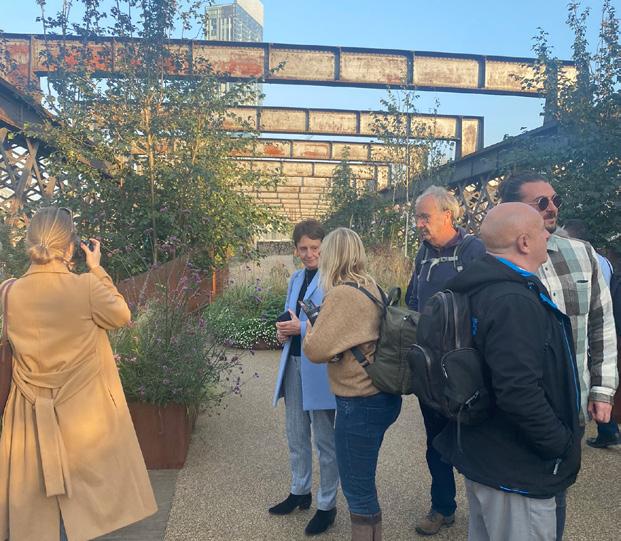
6 minute read
Radical practice: reshaping landscape imaginaries
The purpose of this article is to reflect on the ways landscape architects and landscape managers make and reinforce landscape imaginaries through material specification choices and landscape management practices. By landscape imaginaries, I mean the dominant and collective understandings of how landscapes ought to be. These imaginaries may be expressed through a range of everyday behaviours – from the types of meals consumed, to the way the land is managed, or the policies which receive support.
In all of these activities and behaviours exist a vision for how the landscape is, and perhaps more importantly, how it might be. As landscape practitioners shape the surface of the Earth through management and design processes – whether through direct manipulation of the ground or extraction from it – we intervene directly into these shared understandings, producing particular visions for the future.
In a recent paper published in the Landscape Research journal, ‘Grass-power: the political ecology of the grass crop in Ireland’¹, I show how the grass crop is at the centre of agricultural interest networks: from private and state-sponsored food marketing campaigns to food policies and landscape management practices. Simply put – the grass crop is a powerful agent that dominates in the making of Ireland’s landscape imaginaries. To be sure, I do not aim to attribute intention to the crop, but rather to focus on how an imaginary attaches itself to it and becomes organised around it. The ways in which this happens in one place versus another helps to illustrate the force of landscape imaginaries.
Orla Shortall in her research on forms of dairy production in Ireland versus the UK, for example, finds that pasture-based dairy production is understood as superior in Ireland by dairy farmers, in comparison to its indoor equivalent. Across the UK, on the other hand, dairy farmers do not see either of these forms of dairy farming as clearly better than the other². In regions with climates and geographies not widely dissimilar, this difference points to the central role of the grass crop within Irish landscape imaginaries – Ireland is grass country.
In the Irish context, the grass crop is increasingly deployed as a symbol of sustainability and localised food production. This not only conceals the environmental devastation of, for example, intensive pasture-based dairy production – such as carbon emissions and nitrogen and phosphorous pollution of water systems – but it is also misleading. Recommendations from Ireland’s semi-state agricultural and food development authority (Teagasc) advocate for the reseeding of 10% of Ireland’s pastures annually. Not only would this require a significant increase in the use of glyphosate across hectares of farmland to prepare the ground, but the seed mixtures for Ireland’s grass pastures are also grown from Japan to the Netherlands, and all the way to New Zealand. Landscape imaginaries shape the global environment, so we ought to take them seriously.
Seed origin aside, so much of the framing of Ireland’s landscape relies on the imaginary that the intensiveness and extensiveness of the grass crop is somehow natural, inevitable, and very much of the place. Rather it is increasingly synthetic, globalised, and requiring of intensive management. Whether through landscape design, management or critique, challenging these collective ways of seeing the world are needed – to open opportunities to admit other forms of land use.
What sort of analytical purchase does this have for the practical work of landscape architects and landscape managers? Well, as landscape practitioners, even the smallest decisions can either reinforce or challenge these existing paradigms. Whether in the context of landscape design and planting, landscape management or planning – and at whatever scale – our ability to directly intervene into the living world through our material and managerial specifications can give form to new landscape imaginaries: by showing how things could be different. This is a radical form of individual agency in the climate emergency, uniquely available to all those practicing in the landscape professions.

'Through Thinning Landscapes' installation, Galway, Ireland, 2020. © Both And Group
© Both And Group
To really demonstrate and publicise our thinking around this I worked with colleagues to create ‘Through Thinning Landscapes’ which ran as a temporary installation in September 2020 in the town of Loughrea (Galway, Ireland). Designed together with my colleagues at BothAnd Group (Jarek Adamczuk, Alice Clarke and Kate Rushe) and appointed by design competition, we provided a critique of the relentless greening of the Irish landscape. Responding to an open brief which asked to activate a local park, our submission offered an invitation to the local community to work with us in hosting a conversation about Ireland’s biodiversity crisis.
Situated in a T-shaped park between a field and cattle market, the project challenged the apparent inevitability of the grass crop’s expansive presence and its collaborative role with agribusiness in the destruction of living systems. Commissioned as part of the European Capital of Culture –Galway 2020 – the project aimed to have maximum impact on visiting participants’ landscape imaginations through the curation of an awareness-shifting experience.
The installation gave form – at the scale of the human body – to contemporary patterns of development in the Irish landscape described by the ecologist Pádraic Fogarty as a ‘duoculture’ of cows and grass, with opportunities for life 'squeezed into . . . thin ribbons of treelines and hedgerows'³

'Through Thinning Landscapes' installation, Galway, Ireland, 2020. © Both And Group
© Both And Group
Designed as a 20-metre narrow corridor and hemmed in on both sides by sloped monocultures of perennial ryegrass, the installation ends with a mirror – aiming to position participants within, and to confront, Irish landscape imaginaries which centre the grass crop.
Assembled as an open timber framework the installation was designed to read as a constructed landscape, uncovering the synthetic nature of the Irish countryside. With this we also aimed to articulate the links to the global landscapes upon which the work of landscape design and material production depends.
Robert Smithson communicated this most effectively when considering the work of Olmsted: ‘A park can no longer be seen as “a-thing-in-itself,” but rather as a process of ongoing relationships existing in a physical region’.⁴ This is essential.

'Through Thinning Landscapes' installation, Galway, Ireland, 2020.
© Both And Group
Transforming landscape imaginaries for a warming world will require more than new aesthetic constructs, but a reimagining of the material processes of landscape practice itself.
This project was commissioned by the Irish Architecture Foundation and funded by Galway County Council, Galway 2020 and Creative Ireland.

Andrew Ó Murchú
Co-founder of the landscape research and spatial design collective ‘BothAnd Group’. He is a senior lecturer in architecture at Ravensbourne University London where he leads year two of the undergraduate programme. Previously, he has taught at both TU Dublin and the Bartlett School of Architecture, UCL.
References:
1 Ó Murchú, A. (2022). Grass-power: the political ecology of the grass crop in Ireland. Landscape Research. doi:10.108 0/01426397.2022.212 1810
2 Shortall, O. (2019). Cows eat grass, don’t they? Contrasting sociotechnical imaginaries of the role of grazing in the UK and Irish dairy sectors. Journal of Rural Studies, 72, 45–57. doi:10.1016/j. jrurstud.2019.10.004
3 Fogarty, P. (2017). Whittled Away. Cork, Ireland: The Collins Press. Location 385 of 6396.
4 as cited in Hutton, J. (2017). Reciprocal Landscapes: Stories of Material Movements. Abingdon, UK: Routledge. p.2.










